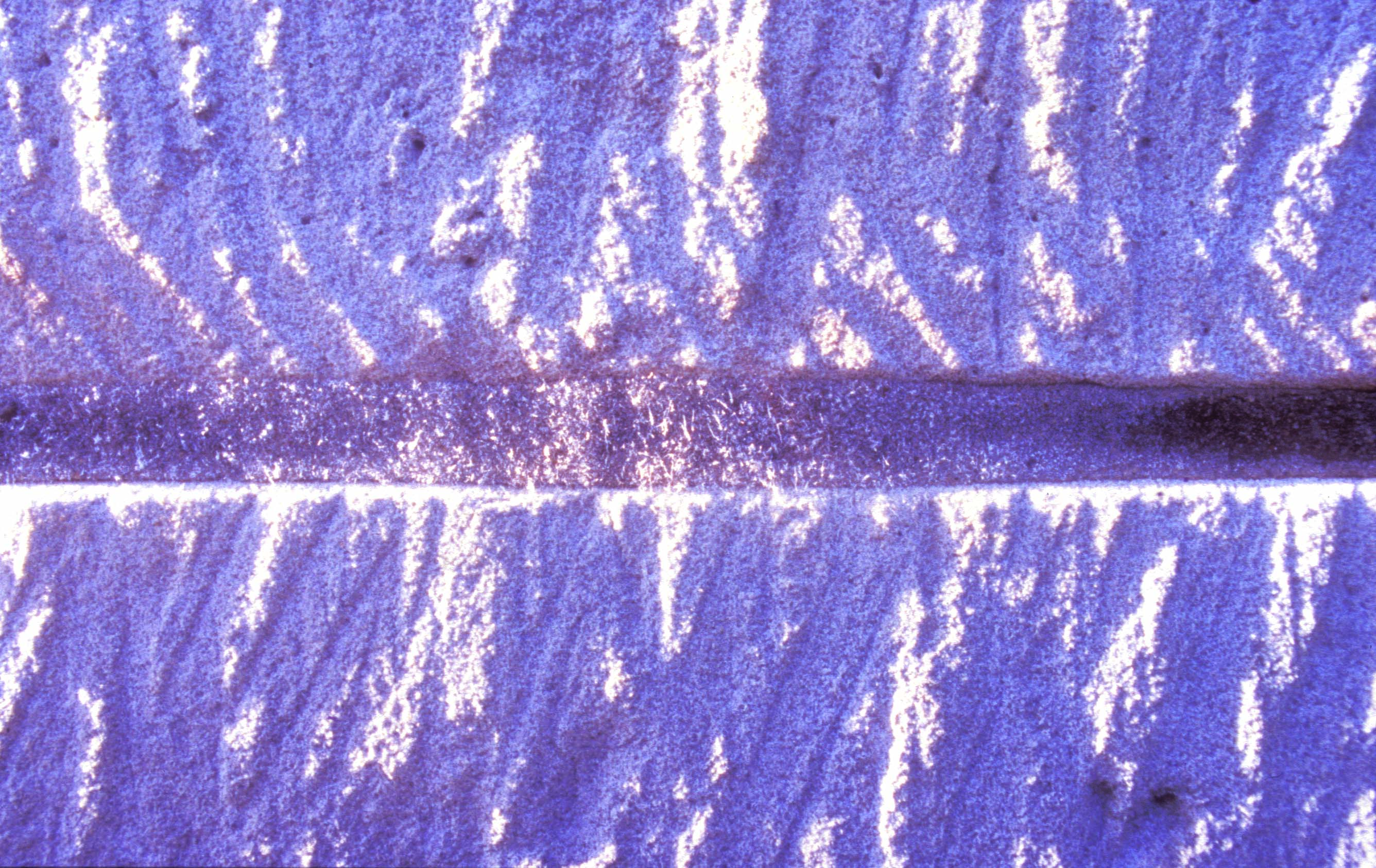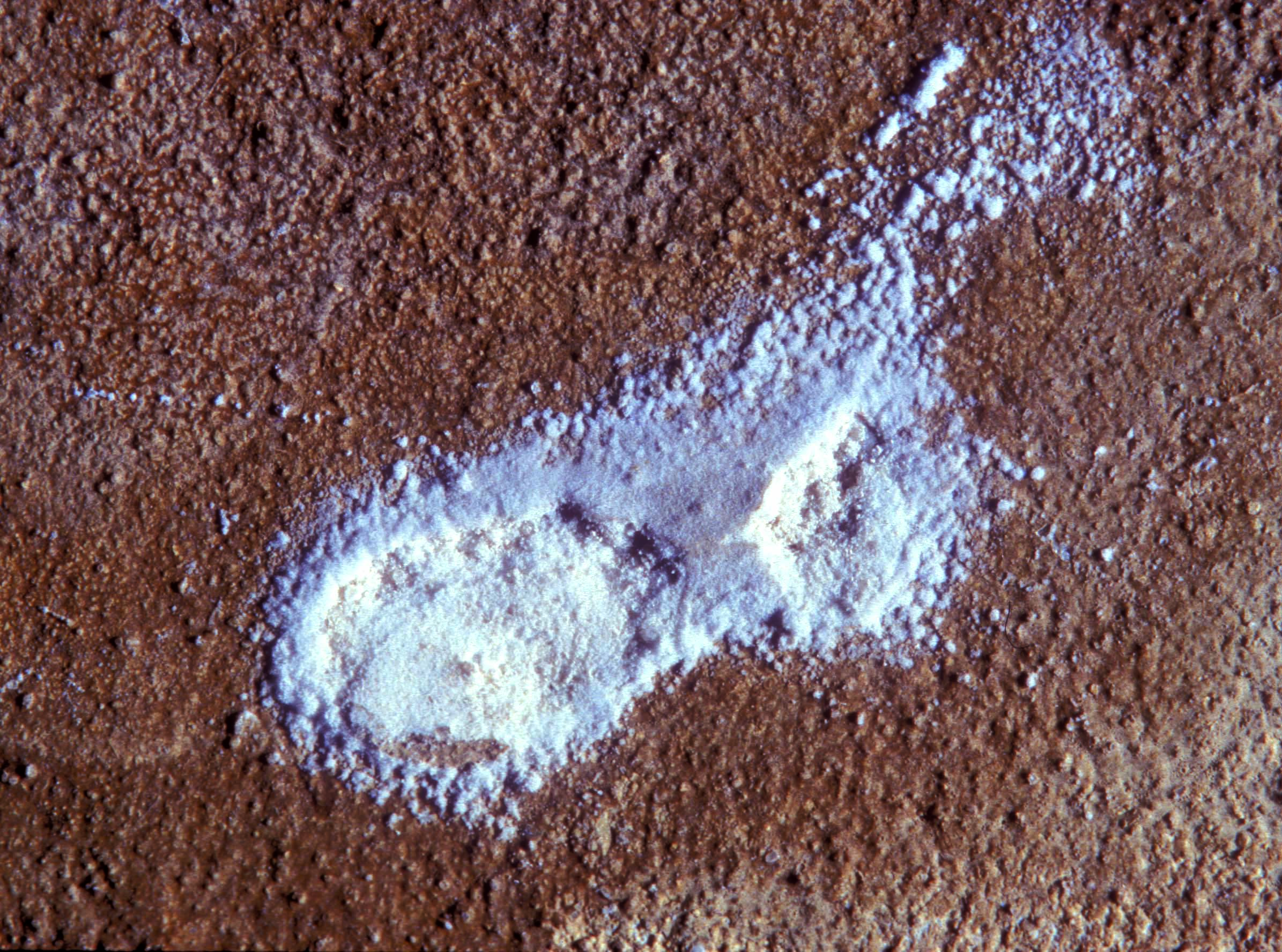Thenardite: Difference between revisions
No edit summary |
|||
| (34 intermediate revisions by 4 users not shown) | |||
| Line 1: | Line 1: | ||
< | Authors: [[user:Hschwarz|Hans-Jürgen Schwarz ]], Michael Steiger, [[user:TMueller|Tim Müller]] <br> | ||
English translation by [[user:MAngeli|Matthieu Angeli]] <br> | |||
back to [[Sulfate]] | |||
{{Infobox_Salt | {{Infobox_Salt | ||
| Line 8: | Line 10: | ||
|Trivial_Name = Pyrotechnite | |Trivial_Name = Pyrotechnite | ||
|chemical_Formula = Na<sub>2</sub>SO<sub>4</sub> | |chemical_Formula = Na<sub>2</sub>SO<sub>4</sub> | ||
|Hydratforms = [[Mirabilite]] (Na<sub>2</sub>SO<sub>4</sub>•10H<sub>2</sub>O)<br> | |Hydratforms = [[Mirabilite]] (Na<sub>2</sub>SO<sub>4</sub>•10H<sub>2</sub>O)<br>[[Sodium sulfate heptahydrate]] (Na<sub>2</sub>SO<sub>4</sub>•7H<sub>2</sub>O) | ||
|Crystal_System = orthorhombic | |Crystal_System = orthorhombic | ||
|Crystal_Structure = | |Crystal_Structure = | ||
| Line 27: | Line 29: | ||
|Phase_Transition = | |Phase_Transition = | ||
|chemBehavior = | |chemBehavior = | ||
|Comments = soluble in water and glycerin,<br> | |Comments = soluble in water and glycerin,<br> insoluble in pure alcohol | ||
|Literature = | |||
}} | }} | ||
= Sodium sulfate and thenardite = | = Sodium sulfate and thenardite = | ||
| Line 39: | Line 39: | ||
== Abstract == | == Abstract == | ||
Thenardite as the anhydrous and stable phase of sodium sulfate and its properties will be presented. <!--Heptahydrate´s role as a major source of damage is also explained.--> | |||
== | == Occurrence == | ||
Both thenardite and [[mirabilite]] occur as natural minerals. In nature sodium sulfate occurs in mineral waters in the form of double salts, as deposits of former salt lakes. The hydrated sodium sulfate was first described by Glauber in 1658 where he called it "sal mirabilis". [[Mirabilite]] is also known as "Glauber's salt" in honor of its discoverer. | |||
== | == Origin and formation of thenardite / mirabilite in monuments == | ||
When sodium ions in conjunction with other anions enter porous inorganic building materials, sodium sulfate may be formed by reaction with sulfate contributed by other sources, for example air contaminated with sulfur oxide gases. Portland cement contains a certain amount of sodium or potassium sulfate. In Germany, the standardization institute (DIN) allows a content of up to 0.5 % soluble alkalis. This means that 100 kg of Portland cement containing only 0.1% soluble Na<sub>2</sub>O can form 520 g of [[Mirabilite]] when reacting with sulfate [calculation by Arnold/Zehnder 1991]. Sodium ions can also enter into monuments from various cleaning materials and, in older restoration products, such as water glass. Ground water, and even surface water, are also a possible source of Na<sup>+</sup>-ions as well as sulfate ions. De-icing road salt may contain a large amount of soluble [[Halite|sodium chloride]]. Finally, in coastal areas, sea water is a significant source of [[Halite|NaCl]]. | |||
== | == Solubility behavior == | ||
[[file:S Na2SO4.jpg|thumb|800px|left|'''Figure 1''': Solubility of Na<sub>2</sub>SO<sub>4</sub> in water, according to : <bib id="Steiger.etal:2008"/>]]<br> | |||
<br clear="all"> | |||
The structures of both thenardite and [[mirabilite]] belong to the group of easily soluble salts (solubility of thenardite at 20 °C: 3.7 mol/kg) and therefore they are easily mobilized (see table [[hygroscopicity of salts and their equilibrium moisture content]]). The solubility of sodium sulfate is highly dependent on temperature. For this reason, a rapid drop of temperature is highly likely to yield very high supersaturation and salt crystallization.<br> | |||
== Hygroscopicity == | |||
= | <br clear="all"> | ||
[[file: | [[file:D Na2SO4e.jpg|thumb|800px|left|'''Figure 2''':Deliquescence of Na<sub>2</sub>SO<sub>4</sub>, according to: <bib id="Steiger.etal:2008"/>]] | ||
<br clear="all"> | |||
The temperature effect on the deliquescence points of thenardite and mirabilite is shown below. The striking features here are the opposite curve transitions for. <br> | |||
For thenardite the deliquescence humidity reaches higher values with increasing temperature (table 1). | |||
<br clear=all> | |||
{|border="2" cellspacing="0" cellpadding="4" width="52%" align="left" class="wikitable" | |||
|+''Tabelle 1: Deliquescence humidity of thenardite and its temperature dependence,according to <bib id="Steiger.etal:2008"/>'' | |||
|- | |||
|bgcolor = "#F0F0F0" align=center| 0°C | |||
|bgcolor = "#F0F0F0" align=center| 10°C | |||
|bgcolor = "#F0F0F0" align=center| 20°C | |||
|bgcolor = "#F0F0F0" align=center| 30°C | |||
|bgcolor = "#F0F0F0" align=center| 40°C | |||
|bgcolor = "#F0F0F0" align=center| 50°C | |||
|- | |||
|bgcolor = "#FFFFEO" align=center| 84.4%r.h. | |||
|bgcolor = "#FFFFEO" align=center| 85.6%r.h. | |||
|bgcolor = "#FFFFEO" align=center| 86.6%r.h. | |||
|bgcolor = "#FFFFEO" align=center| 87.3%r.h. | |||
|bgcolor = "#FFFFEO" align=center| 87.9%r.h. | |||
|bgcolor = "#FFFFEO" align=center| 88.4%r.h. | |||
|} | |||
<br clear=all> | |||
In the presence of other ions (in salt mixtures), the parameters of the equilibrium moisture content, as well as the necessary temperature and humidity conditions for recrystallization, change significantly. The following table shows experimental data of equilibrium moisture for different salt mixtures at different temperatures.It turns out that all the values of equilibrium moisture content are lower than those of the pure salt mirabilite (see table [[equilibrium moisture content as a function of temperature]]). <br> | |||
<br clear="all"> | <br clear="all"> | ||
{|border="2" cellspacing="0" cellpadding="4" width="52%" align="left" class="wikitable" | {|border="2" cellspacing="0" cellpadding="4" width="52%" align="left" class="wikitable" | ||
|+'' | |+''Table 2''' - Information about the equilibrium moisture of saturated solid solutions (mixing ratio: saturated sol.A / saturated sol.B = 1:1) <bib id="Vogt.etal:1993"/>'' | ||
|- | |- | ||
|bgcolor = "#F0F0F0" | | |bgcolor = "#F0F0F0" | | ||
| Line 81: | Line 106: | ||
'''Water vapor sorption: ''' | '''Water vapor sorption: ''' | ||
The table below shows additional information for estimating the hygroscopicity of sodium sulfate for the sorption behavior of pure salt and the mixture with [[Halite]] at different relative | |||
The table below shows additional information for estimating the hygroscopicity of sodium sulfate for the sorption behavior of pure salt and the mixture with [[Halite|halite]] at different relative humidity levels: | |||
<br> | <br> | ||
{|border="2" cellspacing="0" cellpadding="4" width="52%" align="center" class="wikitable" | {|border="2" cellspacing="0" cellpadding="4" width="52%" align="center" class="wikitable" | ||
|+'' | |+''Table 3''': Moist sorption of sodium sulphate in M.% after 56 days of storage [after <bib id="Vogt.etal:1993"/>]'' | ||
|- | |- | ||
|bgcolor = "#F0F0F0" | ''' | |bgcolor = "#F0F0F0" | '''Air humidity''' | ||
|bgcolor = "#F0F0F0" align="center"| '''87% r.F.''' | |bgcolor = "#F0F0F0" align="center"| '''87% r.F.''' | ||
|bgcolor = "#F0F0F0" align="center"| '''81% r.F.''' | |bgcolor = "#F0F0F0" align="center"| '''81% r.F.''' | ||
| Line 99: | Line 124: | ||
|bgcolor = "#FFFFEO" align="center"| 0 | |bgcolor = "#FFFFEO" align="center"| 0 | ||
|- | |- | ||
|bgcolor = "#F7F7F7" | '''Na<sub>2</sub>SO<sub>4</sub>+NaCl''' (1:1 | |bgcolor = "#F7F7F7" | '''Na<sub>2</sub>SO<sub>4</sub>+NaCl''' (1:1 molar mixture) | ||
|bgcolor = "#FFFFEO" align="center"| 157 | |bgcolor = "#FFFFEO" align="center"| 157 | ||
|bgcolor = "#FFFFEO" align="center"| 32 | |bgcolor = "#FFFFEO" align="center"| 32 | ||
| Line 105: | Line 130: | ||
|} | |} | ||
== Crystallization pressure | ==Crystallization pressure== | ||
For the crystallization from an aqueous solution a crystallization pressure of 29.2 - 34.5 N/mm<sup>2</sup> for thenardite can be expected. In comparism to other calculated pressures of other salts that might damage building materials, thenardite is able to exert high crystallization pressure <bib id="Winkler:1975"/>. | |||
== Hydration behavior == | == Hydration behavior == | ||
| Line 114: | Line 140: | ||
The Na<sub>2</sub>SO<sub>4</sub> – H<sub>2</sub>O system: | The Na<sub>2</sub>SO<sub>4</sub> – H<sub>2</sub>O system: | ||
The only stable forms are the decahydrate ([[ | The only stable forms of sodium sulfate are the decahydrate ([[mirabilite]]) and the anhydrite (thenardite). The generation of mirabilite by recrystallization of the salt from an aqueous supersaturated solution occurs at 32.4°C. In particular, the transition from thenardite to mirabilite and the incorporation of 10 water molecules in the crystal lattice causes a volume expansion of 320%. This transition happens at a relatively low temperature (32-35°C), the damage caused by this salt is highly dependent on the temperature and thus on the environment. This temperature range is given as a guide, because this transition could happen for example at 25°C at 80% relative humidity, or even at 0°C at 60.7% relative humidity [information from Gmelin]. Due to this strong dependence on the environmental parameters, an estimate of the damage caused on buildings by crystallization and hydration of sodium sulfate are very difficult to obtain. | ||
== Hydration pressure == | == Hydration pressure == | ||
<!-- | |||
The hydration pressure, which occurs at the transition from thenardite to [[mirabilite]], is highly dependent on the existing relative humidity and temperature conditions. This correlation is shown in table 3 as follows: | |||
<br clear="all"> | <br clear="all"> | ||
{|border="2" cellspacing="0" cellpadding="4" width="52%" align="left" class="wikitable" | {|border="2" cellspacing="0" cellpadding="4" width="52%" align="left" class="wikitable" | ||
|+'' | |+''Table 3''': Hydration pressure thenardite-[[mirabilite]] nach <bib id="Winkler.etal:1970"/>'' | ||
|- | |- | ||
|bgcolor = "#F0F0F0" align=center| ''' | |bgcolor = "#F0F0F0" align=center| '''RH %''' | ||
|bgcolor = "#F0F0F0" align=center| '''20.0 °C''' | |bgcolor = "#F0F0F0" align=center| '''20.0 °C''' | ||
|bgcolor = "#F0F0F0" align=center| '''25.0 °C''' | |bgcolor = "#F0F0F0" align=center| '''25.0 °C''' | ||
| Line 163: | Line 188: | ||
<br clear=all> | <br clear=all> | ||
The change in volume, taking place during phase transition, is to be specified at approx. 320%. | |||
<bib id="Sperling.etal:1980"/>. | |||
--> | |||
== Analytical detection == | == Analytical detection == | ||
=== Microscopy<br> === | === Microscopy<br> === | ||
''' | '''Laboratory investigation:'''<br> Through microscopic observations regarding the solubility behavior, good solubility in water and no solubility in ethanol can be confirmed. Thenardite and mirabilite do not have morphological characteristics that could help identification with the use of simple re-crystallization experiments. | ||
<br> | |||
''' | '''Refractive indices:''' n<sub>x</sub> = 1.468; n<sub>y</sub> =1,473; n<sub>z</sub> =1.483<br> | ||
'''Birefringence''': Δ = 0.015<br> | |||
'''Crystal class''': orthorhombic<br> | |||
<br> | <br> | ||
'''[[ | '''[[Polarized light microscopy]] examination:'''<br> | ||
<br> | The raw sampling material and the re-crystallized preparation change their water content, depending on the conditions of relative humidity and temperature. | ||
In dry air conditions (RH < 80% and room temperature) [[mirabilite]] looses its chemically bound water and changes to thenardite. This process can be clearly understood and reproduced using a microscope, when the process of re-crystallization is observed. Mirabillite does show the characteristic abnormal interference colors. During the moisture loss and the formation of thenardite these abnormal interference colors become weaker.<br><br>The refractive index assignment of thenardite is carried out using the immersion method. Due to the low maximum birefringence, thenardite mostly displays gray interference colors. The extinction is parallel or symmetrical. | |||
<br>'''Possible mistakes:''' | |||
Generally, the differentiation between certain kinds of sulfates (they are listed below, thenardite included) is a problem without micro-chemical determination of the anions, because the refractive indices of the salts lie very closely together and all salts show a low birefringence. It is best to use an immersion medium with a n<sub>D</sub>- value of 1,48, thus making the differentiation within this group possible. Moreover, the properties mentioned below can be consulted as criteria for determination. | |||
Thenardite is unambiguously, but indirectly determined by re-crystallizing a sample and observing the abnormal interference colors, which occur when mirabiltite is identified in its high hydrate form. | |||
{|border="2" cellspacing="0" cellpadding="4" width="100%" align="left" class="wikitable" | {|border="2" cellspacing="0" cellpadding="4" width="100%" align="left" class="wikitable" | ||
|+'' | |+''Table 3''': Characteristics for differentiating thenardite from other sulfates'' | ||
|- | |- | ||
|bgcolor = "#F0F0F0"| ''' | |bgcolor = "#F0F0F0"| '''Salt phase''' | ||
|bgcolor = "#F0F0F0"| ''' | |bgcolor = "#F0F0F0"| '''Characteristic''' | ||
|- | |- | ||
|bgcolor = "#F7F7F7"| '''[[ | |bgcolor = "#F7F7F7"| '''[[Boussingaultite]]''' (NH<sub>4</sub>)<sub>2</sub>Mg(SO)<sub>4</sub> • 6H<sub>2</sub>0 | ||
|bgcolor = "#FFFFEO"| | |bgcolor = "#FFFFEO"| no abnormal interference colors/ inclined extinction | ||
|- | |- | ||
|bgcolor = "#F7F7F7"| '''[[ | |bgcolor = "#F7F7F7"| '''[[Schönite|Pikromerite]]''' K<sub>2</sub>Mg(SO<sub>4</sub>)<sub>2</sub> • 6H<sub>2</sub>0 | ||
|bgcolor = "#FFFFEO"| | |bgcolor = "#FFFFEO"| no abnormal interference colors/ inclined extinction | ||
|- | |- | ||
|bgcolor = "#F7F7F7"|'''[[ | |bgcolor = "#F7F7F7"|'''[[Astrakanite|Bloedite]]''' Na<sub>2</sub>Mg(SO<sub>4</sub>)<sub>2</sub> • 6H<sub>2</sub>0 | ||
|bgcolor = "#FFFFEO"| | |bgcolor = "#FFFFEO"| all indices >1.48 / no abnormal interference colors/ inclined extinction / optically negative orientation. | ||
|- | |- | ||
|bgcolor = "#F7F7F7"| '''[[ | |bgcolor = "#F7F7F7"| '''[[Aphthitalite|Glaserite]]''' K<sub>3</sub>Na(SO<sub>4</sub>)<sub>2</sub> | ||
|bgcolor = "#FFFFEO"| | |bgcolor = "#FFFFEO"| all indizes >1.48 / no abnormal interference colors/ inclined extinction | ||
|- | |- | ||
|bgcolor = "#F7F7F7"| '''[[ | |bgcolor = "#F7F7F7"| '''[[Arcanite]]''' K<sub>2</sub>SO<sub>4</sub> | ||
|bgcolor = "#FFFFEO"| | |bgcolor = "#FFFFEO"| all indices >1.48 / no abnormal interference colors | ||
|- | |- | ||
|bgcolor = "#F7F7F7"| '''[[ | |bgcolor = "#F7F7F7"| '''[[Magnesium formiate]]''' Mg(HCO<sub>2</sub>)<sub>2</sub> • 2H<sub>2</sub>O | ||
|bgcolor = "#FFFFEO"| | |bgcolor = "#FFFFEO"| comparatively high birefringence / no abnormal interference colors/ inclined extinction | ||
|} | |} | ||
<br> | <br> | ||
''' | '''Observation of mixed systems:''' | ||
The mixed system Na<sup>+</sup>– Ca<sup>2+</sup>– SO<sub>4</sub> <sup>2-</sup>: The precipitation of [[gypsum]] takes place first during re-crystallization, which is due to its low solubility. The distinct needle like habit of single gypsum crystals and aggregates remains. | |||
The precipitation of sodium sulfate takes place later. The actual crystal growth takes place much faster. The morphology is non-specific. | |||
--> | Mixed system Na<sup>+</sup>– SO<sub>4</sub> <sup>2-</sup>– Cl<sup>-</sup>: The precipitation of both kinds of particle starts approximately at the same time, [[halite]] with its characteristic morphology, [[sodium sulfate]] in extremely varying forms. | ||
<!-- | <!-- | ||
=== X-ray diffractometry === | === X-ray diffractometry === | ||
| Line 230: | Line 259: | ||
<br> | <br> | ||
<br> | <br> | ||
--> | --> | ||
| Line 237: | Line 265: | ||
=== In the field === | === In the field === | ||
<gallery caption=" | <gallery caption="Thenardite efflorescences" widths="200px" heights="150px" perrow="3"> | ||
Image:Idensen,_Thenardit_ausbluehung_aussen.jpg| | Image:Idensen,_Thenardit_ausbluehung_aussen.jpg|Thenardite crystals on a wall in the old church in Idensen, Germany | ||
Image: | Image:Eilsumpudrigeausbluehungen.jpg|Thenardite efforescences in the Ev. Ref. church in Eilsum, Germany | ||
</gallery> | </gallery> | ||
<!-- | |||
=== Under the polarizing microscope === | === Under the polarizing microscope === | ||
<gallery caption=" | <gallery caption="Sodium sulfate crystals between to glass plates " widths="200px" heights="150px" perrow="3"> | ||
Image:HJS Na2SO4-slides-6.jpg | | Image:HJS Na2SO4-slides-6.jpg |plain polarized light | ||
Image:HJS Na2SO4-slides-1.jpg| | Image:HJS Na2SO4-slides-1.jpg| crossed polarisers, red I | ||
Image: | | Image: | | ||
Image:HJS Na2SO4-slides-110703-10x-3.jpg| | Image:HJS Na2SO4-slides-110703-10x-3.jpg|plain polarized light | ||
Image:HJS Na2SO4-slides-110703-10x-2.jpg| | Image:HJS Na2SO4-slides-110703-10x-2.jpg| crossed polarisers | ||
Image:HJS Na2SO4-slides-110703-10x-1.jpg| | Image:HJS Na2SO4-slides-110703-10x-1.jpg| crossed polarisers, red I | ||
Image:HJS Na2SO4-slides-2-110603.jpg| | Image:HJS Na2SO4-slides-2-110603.jpg|plain polarized light | ||
Image:HJS Na2SO4-slides-1-110603.jpg| | Image:HJS Na2SO4-slides-1-110603.jpg| crossed polarisers, red I | ||
Image: | | Image: | | ||
Image:HJS-Na2SO4-111703-02-10x.jpg| | Image:HJS-Na2SO4-111703-02-10x.jpg|plain polarized light | ||
Image:HJS-Na2SO4-111703-04-10x.jpg| | Image:HJS-Na2SO4-111703-04-10x.jpg|plain polarized light | ||
Image:HJS-Na2SO4-111703-01-10x.jpg| | Image:HJS-Na2SO4-111703-01-10x.jpg| crossed polarisers, red I | ||
</gallery> | </gallery> | ||
| Line 264: | Line 293: | ||
<br> | <br> | ||
<gallery caption=" | <gallery caption="Sodium sulfate crystals, crystallised out of a water extraction of a real sample" widths="200px" heights="150px" perrow="3"> | ||
Image:HJS Na2SO4 092503-3.jpg| | Image:HJS Na2SO4 092503-3.jpg|plain polarized light | ||
Image:HJS Na2SO4 092503-4.jpg| | Image:HJS Na2SO4 092503-4.jpg|plain polarized light | ||
</gallery> | </gallery> | ||
=== Under the Scanning Electron Microscope === | === Under the Scanning Electron Microscope === | ||
--> | |||
== Weblinks<br> == | == Weblinks<br> == | ||
<references /> | <references/> | ||
== Literature == | == Literature == | ||
< | <biblist/> | ||
[[Category:Thenardite]][[Category:Sulphate]][[Category:Salt]][[Category: | [[Category:Thenardite]][[Category:Sulphate]][[Category:Salt]][[Category:Sulfate]][[Category:inReview]][[Category:Müller,Tim]][[Category:List]][[Category:Schwarz,Hans-Jürgen]] | ||
Latest revision as of 07:46, 3 May 2023
Authors: Hans-Jürgen Schwarz , Michael Steiger, Tim Müller
English translation by Matthieu Angeli
back to Sulfate
| Thenardite[1][2] | |
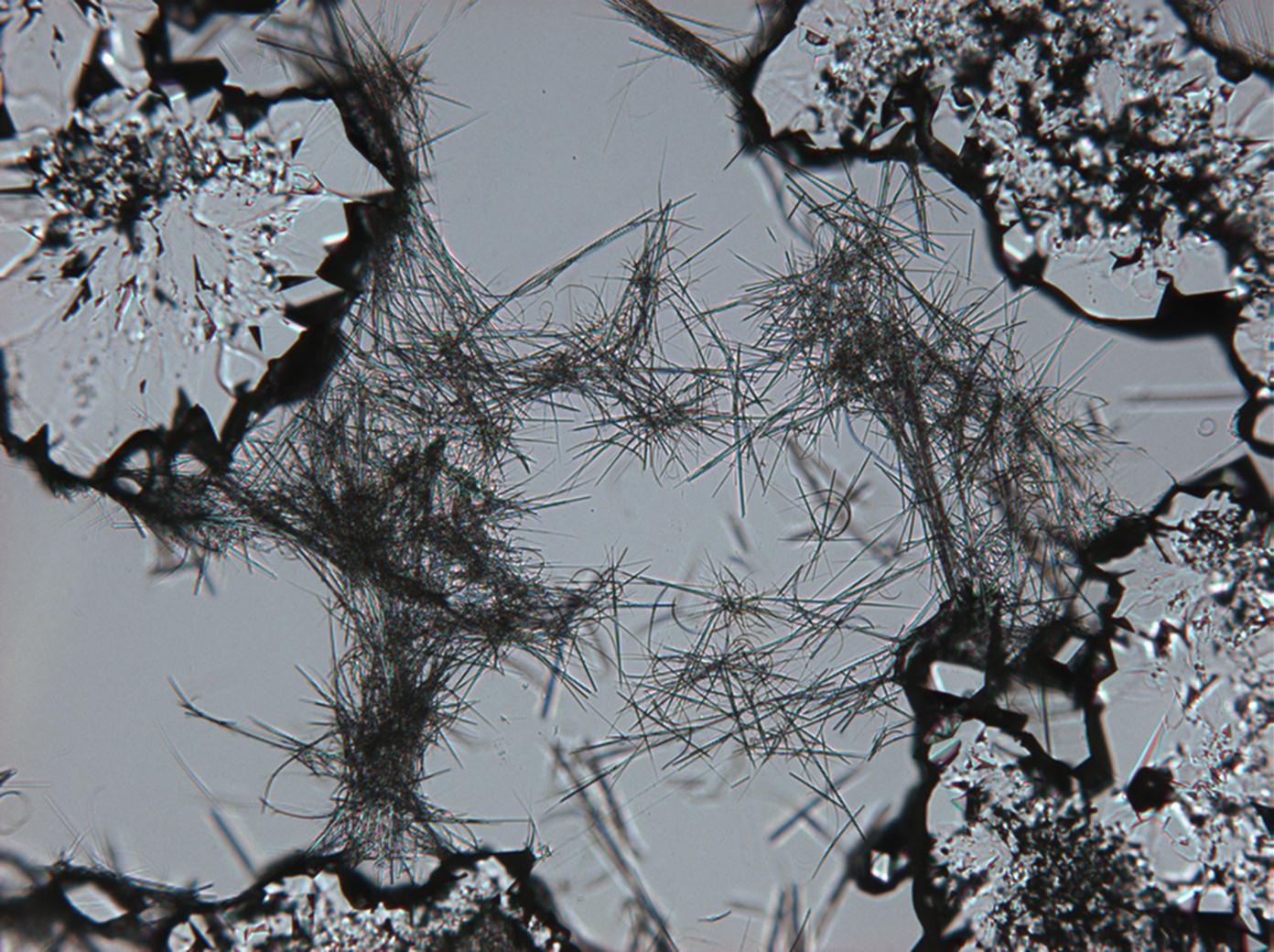
| |
| Mineralogical name | Thenardite |
| Chemical name | Sodium sulfate |
| Trivial name | Pyrotechnite |
| Chemical formula | Na2SO4 |
| Other forms | Mirabilite (Na2SO4•10H2O) Sodium sulfate heptahydrate (Na2SO4•7H2O) |
| Crystal system | orthorhombic |
| Crystal structure | |
| Deliquescence humidity 20°C | 81.7% (25°C) |
| Solubility (g/l) at 20°C | 162 g/l |
| Density (g/cm³) | 2.689 g/cm³ |
| Molar volume | 53.11 cm3/mol |
| Molar weight | 142.04 g/mol |
| Transparency | transparent to translucent |
| Cleavage | perfect |
| Crystal habit | |
| Twinning | |
| Phase transition | |
| Chemical behavior | |
| Comments | soluble in water and glycerin, insoluble in pure alcohol |
| Crystal Optics | |
| Refractive Indices | nx = 1.468 ny = 1.473 nz = 1.483 |
| Birefringence | Δ = 0.015 |
| Optical Orientation | positive |
| Pleochroism | |
| Dispersion | |
| Used Literature | |
Sodium sulfate and thenardite[edit]
Abstract[edit]
Thenardite as the anhydrous and stable phase of sodium sulfate and its properties will be presented.
Occurrence[edit]
Both thenardite and mirabilite occur as natural minerals. In nature sodium sulfate occurs in mineral waters in the form of double salts, as deposits of former salt lakes. The hydrated sodium sulfate was first described by Glauber in 1658 where he called it "sal mirabilis". Mirabilite is also known as "Glauber's salt" in honor of its discoverer.
Origin and formation of thenardite / mirabilite in monuments[edit]
When sodium ions in conjunction with other anions enter porous inorganic building materials, sodium sulfate may be formed by reaction with sulfate contributed by other sources, for example air contaminated with sulfur oxide gases. Portland cement contains a certain amount of sodium or potassium sulfate. In Germany, the standardization institute (DIN) allows a content of up to 0.5 % soluble alkalis. This means that 100 kg of Portland cement containing only 0.1% soluble Na2O can form 520 g of Mirabilite when reacting with sulfate [calculation by Arnold/Zehnder 1991]. Sodium ions can also enter into monuments from various cleaning materials and, in older restoration products, such as water glass. Ground water, and even surface water, are also a possible source of Na+-ions as well as sulfate ions. De-icing road salt may contain a large amount of soluble sodium chloride. Finally, in coastal areas, sea water is a significant source of NaCl.
Solubility behavior[edit]
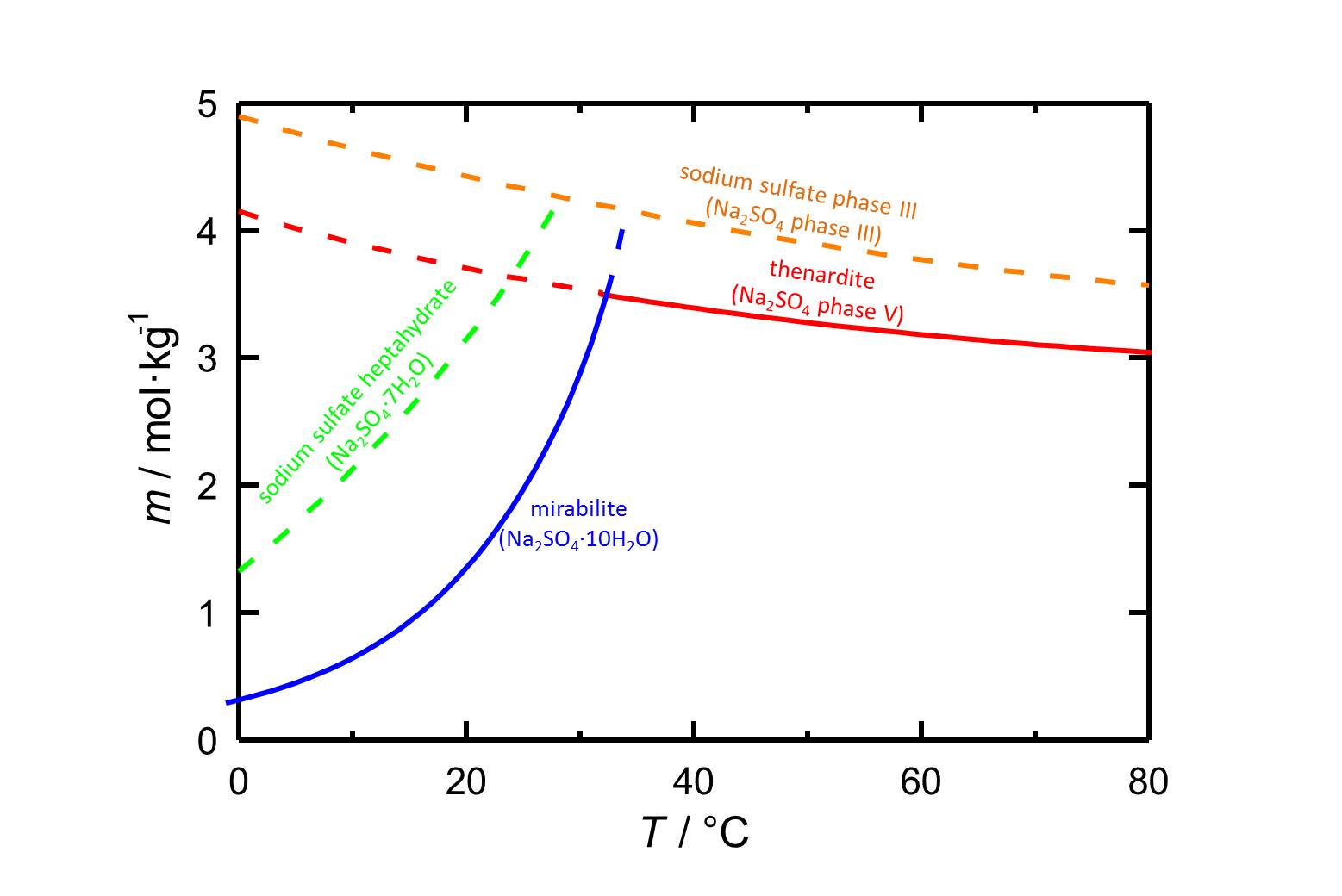
Author: Steiger, Michael; Asmussen, Sönke

The structures of both thenardite and mirabilite belong to the group of easily soluble salts (solubility of thenardite at 20 °C: 3.7 mol/kg) and therefore they are easily mobilized (see table hygroscopicity of salts and their equilibrium moisture content). The solubility of sodium sulfate is highly dependent on temperature. For this reason, a rapid drop of temperature is highly likely to yield very high supersaturation and salt crystallization.
Hygroscopicity[edit]
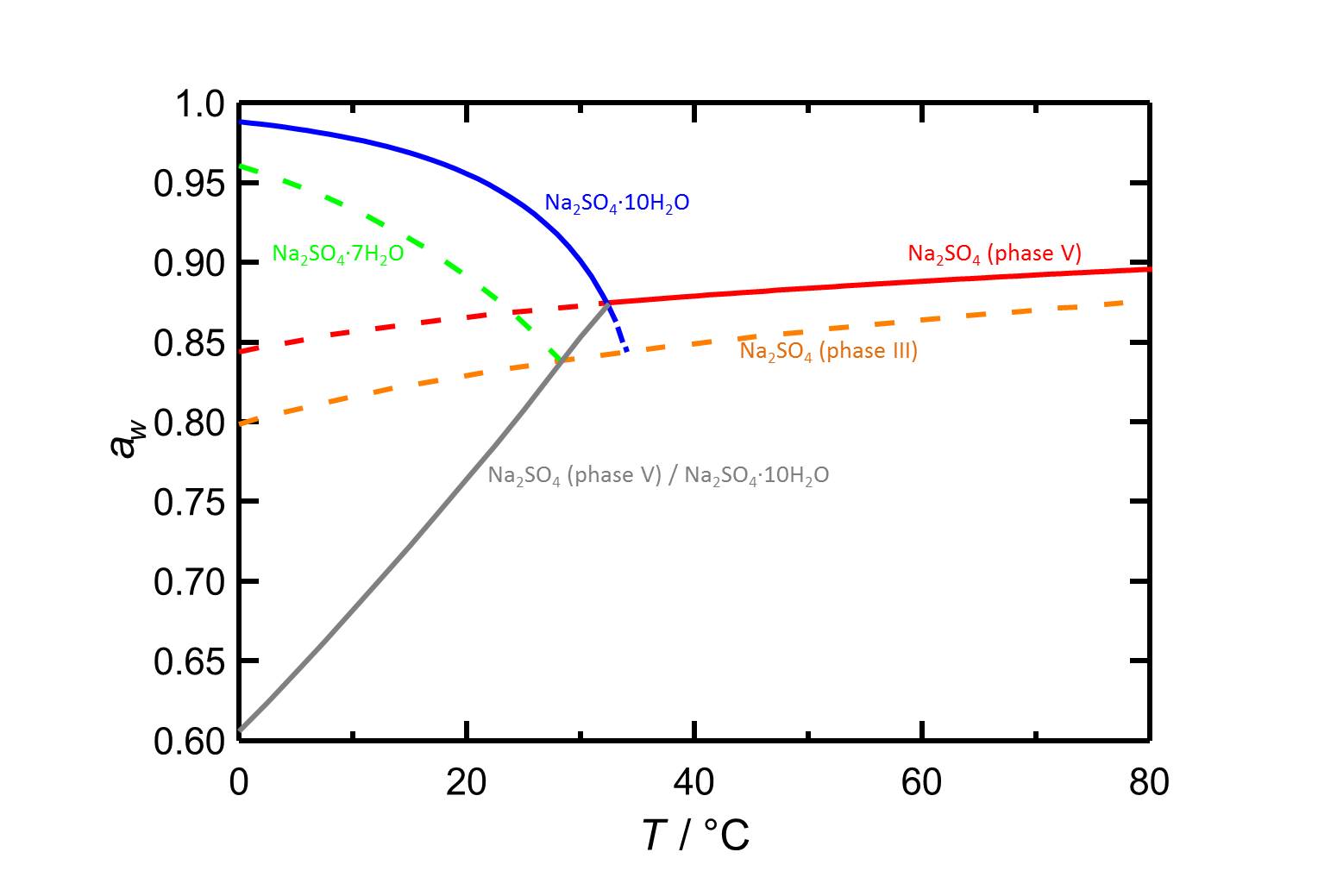
Author: Steiger, Michael; Asmussen, Sönke

The temperature effect on the deliquescence points of thenardite and mirabilite is shown below. The striking features here are the opposite curve transitions for.
For thenardite the deliquescence humidity reaches higher values with increasing temperature (table 1).
| 0°C | 10°C | 20°C | 30°C | 40°C | 50°C |
| 84.4%r.h. | 85.6%r.h. | 86.6%r.h. | 87.3%r.h. | 87.9%r.h. | 88.4%r.h. |
In the presence of other ions (in salt mixtures), the parameters of the equilibrium moisture content, as well as the necessary temperature and humidity conditions for recrystallization, change significantly. The following table shows experimental data of equilibrium moisture for different salt mixtures at different temperatures.It turns out that all the values of equilibrium moisture content are lower than those of the pure salt mirabilite (see table equilibrium moisture content as a function of temperature).
| MgSO4 | Ca(NO3)2 | KNO3 | |
| Na2SO4 • 10H2O | 87(21°C) | 74 (21°C) | 81(21°C) |
Water vapor sorption:
The table below shows additional information for estimating the hygroscopicity of sodium sulfate for the sorption behavior of pure salt and the mixture with halite at different relative humidity levels:
| Air humidity | 87% r.F. | 81% r.F. | 79% r.F. |
| Na2SO4 | 79 | 0 | 0 |
| Na2SO4+NaCl (1:1 molar mixture) | 157 | 32 | 15 |
Crystallization pressure[edit]
For the crystallization from an aqueous solution a crystallization pressure of 29.2 - 34.5 N/mm2 for thenardite can be expected. In comparism to other calculated pressures of other salts that might damage building materials, thenardite is able to exert high crystallization pressure [Winkler:1975]Title: Stone: Properties, Durability in Man´s Environment
Author: Winkler, Erhard M. .
.
Hydration behavior[edit]
The Na2SO4 – H2O system:
The only stable forms of sodium sulfate are the decahydrate (mirabilite) and the anhydrite (thenardite). The generation of mirabilite by recrystallization of the salt from an aqueous supersaturated solution occurs at 32.4°C. In particular, the transition from thenardite to mirabilite and the incorporation of 10 water molecules in the crystal lattice causes a volume expansion of 320%. This transition happens at a relatively low temperature (32-35°C), the damage caused by this salt is highly dependent on the temperature and thus on the environment. This temperature range is given as a guide, because this transition could happen for example at 25°C at 80% relative humidity, or even at 0°C at 60.7% relative humidity [information from Gmelin]. Due to this strong dependence on the environmental parameters, an estimate of the damage caused on buildings by crystallization and hydration of sodium sulfate are very difficult to obtain.
Hydration pressure[edit]
Analytical detection[edit]
Microscopy
[edit]
Laboratory investigation:
Through microscopic observations regarding the solubility behavior, good solubility in water and no solubility in ethanol can be confirmed. Thenardite and mirabilite do not have morphological characteristics that could help identification with the use of simple re-crystallization experiments.
Refractive indices: nx = 1.468; ny =1,473; nz =1.483
Birefringence: Δ = 0.015
Crystal class: orthorhombic
Polarized light microscopy examination:
The raw sampling material and the re-crystallized preparation change their water content, depending on the conditions of relative humidity and temperature.
In dry air conditions (RH < 80% and room temperature) mirabilite looses its chemically bound water and changes to thenardite. This process can be clearly understood and reproduced using a microscope, when the process of re-crystallization is observed. Mirabillite does show the characteristic abnormal interference colors. During the moisture loss and the formation of thenardite these abnormal interference colors become weaker.
The refractive index assignment of thenardite is carried out using the immersion method. Due to the low maximum birefringence, thenardite mostly displays gray interference colors. The extinction is parallel or symmetrical.
Possible mistakes:
Generally, the differentiation between certain kinds of sulfates (they are listed below, thenardite included) is a problem without micro-chemical determination of the anions, because the refractive indices of the salts lie very closely together and all salts show a low birefringence. It is best to use an immersion medium with a nD- value of 1,48, thus making the differentiation within this group possible. Moreover, the properties mentioned below can be consulted as criteria for determination. Thenardite is unambiguously, but indirectly determined by re-crystallizing a sample and observing the abnormal interference colors, which occur when mirabiltite is identified in its high hydrate form.
| Salt phase | Characteristic |
| Boussingaultite (NH4)2Mg(SO)4 • 6H20 | no abnormal interference colors/ inclined extinction |
| Pikromerite K2Mg(SO4)2 • 6H20 | no abnormal interference colors/ inclined extinction |
| Bloedite Na2Mg(SO4)2 • 6H20 | all indices >1.48 / no abnormal interference colors/ inclined extinction / optically negative orientation. |
| Glaserite K3Na(SO4)2 | all indizes >1.48 / no abnormal interference colors/ inclined extinction |
| Arcanite K2SO4 | all indices >1.48 / no abnormal interference colors |
| Magnesium formiate Mg(HCO2)2 • 2H2O | comparatively high birefringence / no abnormal interference colors/ inclined extinction |
Observation of mixed systems:
The mixed system Na+– Ca2+– SO4 2-: The precipitation of gypsum takes place first during re-crystallization, which is due to its low solubility. The distinct needle like habit of single gypsum crystals and aggregates remains. The precipitation of sodium sulfate takes place later. The actual crystal growth takes place much faster. The morphology is non-specific.
Mixed system Na+– SO4 2-– Cl-: The precipitation of both kinds of particle starts approximately at the same time, halite with its characteristic morphology, sodium sulfate in extremely varying forms.
Pictures of salt and salt damage[edit]
In the field[edit]
- Thenardite efflorescences
Weblinks
[edit]
- ↑ http://webmineral.com/data/Thenardite.shtml viewed on 29/07/2010
- ↑ http://www.mindat.org/min-3935.html viewed on 29/07/2010
Literature[edit]
| [Sperling.etal:1980] | Sperling, C.H.B.and Cooke, R.U. (1980): Salt Weathering on Arid Environment, I. Theoretical ConsiderationsII. Laboratory Studies. In: Papers in Geography, 8 () |  |
| [Steiger.etal:2008] | Steiger, Michael; Asmussen, Sönke (2008): Crystallization of sodium sulfate phases in porous materials: The phase diagram Na2SO4–H2O and the generation of stress. In: Geochimica et Cosmochimica Acta, 72 (17), 4291-4306, Url |  |
| [Vogt.etal:1993] | Vogt, R.; Goretzki, Lothar (1993): Der Einfluss hygroskopischer Salze auf die Gleichgewichtsfeuchte und Trocknung anorganischer Baustoffe, unveröffentlichter Bericht. |  |
| [Winkler.etal:1970] | Winkler, Erhard M.; Wilhelm, E.J. (1970): Saltburst by Hydration Pressure in Architectural Stone in Urban Atmosphere. In: Geological Society of America, Bulletin, 81 (), 567-572 |  |
| [Winkler:1975] | Winkler, Erhard M. (1975): Stone: Properties, Durability in Man´s Environment, Springer Verlag, Wien |  |
